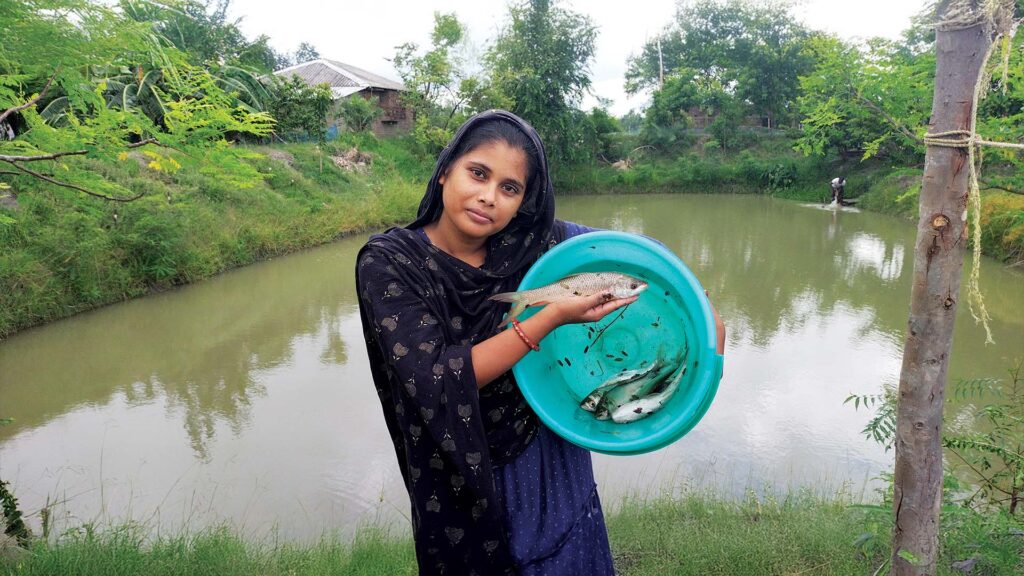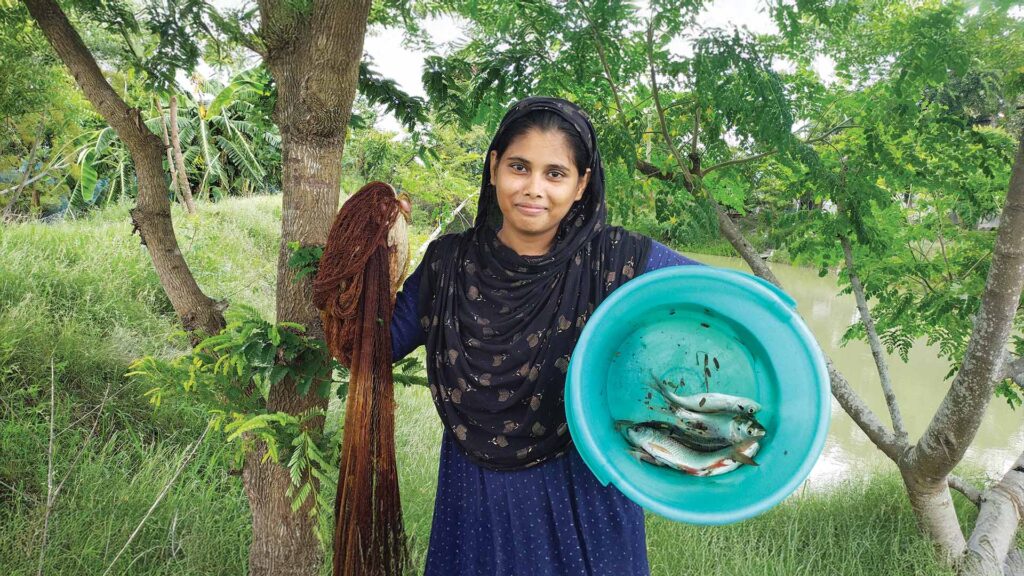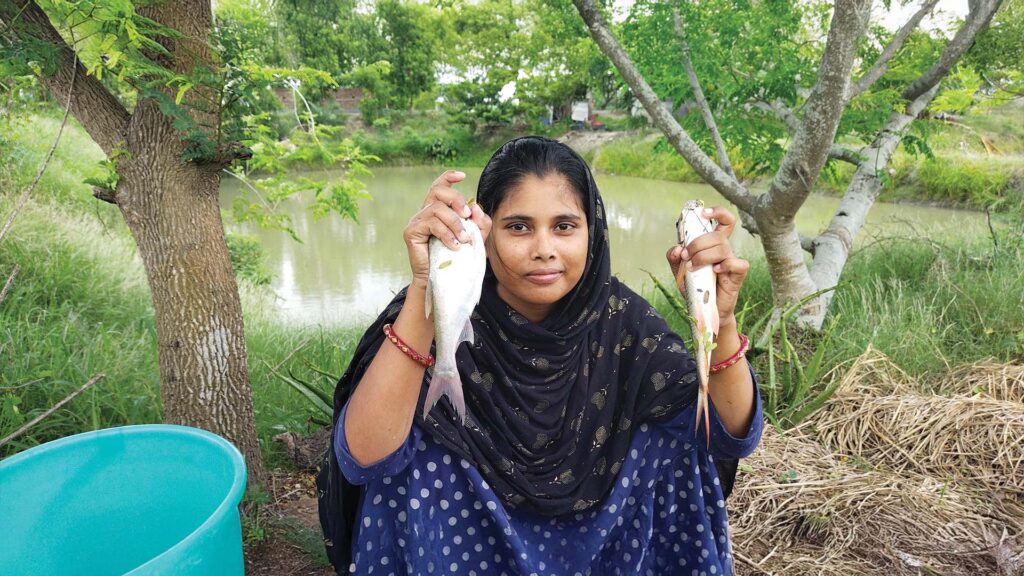
🐠 Our Pond, Our Pride: A Guide to Bengali Village Pond Fish
By Asgar Molla | Tahamina Molla | Our Father
📍 Sundarban, India
📝 A Day by Our Pond: Fresh Fish and Family Moments
In the heart of the Sundarbans, nestled beside our ancestral home, flows a quiet rhythm of life around a humble village pond. This pond is not just a waterbody—it is the soul of our home. A source of livelihood, love, and legacy. For generations, it has offered us food, taught us patience, and bonded us as a family, reflecting the true essence of Bengali culture and food.
Early one misty morning, with fishing net in hand and hearts full of memories, we—Asgar Molla, Tahamina Molla, and our Father—walked to the pond just like we used to during childhood. Each cast of the net was not only about catching fish, but also pulling up stories from the water—memories of childhood laughter, festive gatherings, and delicious home-cooked meals rooted in Bengali culture and food.
Fishing is a ritual here, a celebration of simplicity and sustenance. What we bring home is more than a catch—it’s culture, nutrition, and emotion served on a plate.
🎣 Bengali Pond Fish Species: 14 Local Favourites from Our Village
From nutritious small fish to majestic freshwater giants, Bengali ponds host a rich variety of species. Here’s a lovingly curated guide to 14 freshwater fishes that grace our village tables—complete with Bengali names, weight range, price estimates, and why they matter to us in Bengali culture and food.
🌾 Why This Pond Means Everything to Us
For many urban dwellers, fish comes neatly packed from a supermarket. But here, in the villages of rural Bengal, every fish has a face, a story, a memory. It’s about catching your lunch before cooking it. It’s about feeding your family with what nature offers you. It’s about giving your children the joy of seeing how life sustains itself—a living example of Bengali culture and food.
And every member of the family has a role. Fathers teach the fishing tricks. Daughters clean the catch. Mothers cook with soul. And children? They chase dragonflies on the banks as laughter fills the air, bringing alive the timeless beauty of Bengali culture and food.

🎣 Bengali Pond Fish Species & Details – 14 Traditional Favourites
Let us take you on a heartfelt journey through the 14 types of fish that commonly live in Bengali village ponds—complete with names, weight, market prices, and their deep connection to our food, family, and Bengali culture and food.
🐟 1. Rohu (রুই মাছ)
- Scientific Name: Labeo rohita
- Average Weight: 2–5 kg (can grow up to 10 kg)
- Market Price: ₹200–₹300/kg
Description:
Rohu is the king of Bengali ponds and kitchens, the fish that defines our identity. In village life, catching a large Rohu is like finding treasure; it brings festive joy to the entire family. The aroma of Rui Maacher Jhol simmering in mustard oil is a childhood memory for every Bengali. Rohu symbolizes prosperity and celebration—it is served at weddings, rice-feeding ceremonies (অন্নপ্রাশন), and festive Durga Puja lunches. Its firm, mildly sweet flesh absorbs mustard, cumin, and coriander beautifully, making dishes like Shorshe Rui or Doi Rui eternal family favorites. For us, Rohu is not just a fish—it’s heritage served on a plate, the heart of Bengali culture and food.
🐟 2. Catla (কাতলা মাছ)
- Scientific Name: Catla catla
- Average Weight: 3–6 kg (can exceed 15 kg)
- Market Price: ₹220–₹350/kg
Description:
Catla is the giant warrior of our pond, loved for its huge head and rich belly fat. In rural Bengal, a Catla head curry (কাতলার মাথা দিয়ে ডাল বা বাঁধাকপি) is a dish of pride, often served when special guests visit. Sunday lunches with Catla belly in mustard gravy are family traditions, where children fight over the soft belly fat while elders savor the head curry with steaming rice. Catla fishing days are celebrations—villagers gather, cheer, and sometimes offer a silent prayer, for a big Catla can feed many families. Its taste is rich, comforting, and deeply tied to homecoming meals in Bengali culture and food.
🐟 3. Mrigal (মৃগেল মাছ)
- Scientific Name: Cirrhinus mrigala
- Average Weight: 1.5–3 kg
- Market Price: ₹180–₹250/kg
Description:
Mrigal is the humble friend of the rural kitchen, the everyday fish that nourishes families silently. Its soft flesh and mild taste make it ideal for daily curries, khichuri meals on rainy days, or light jhols with vegetables. In our home, Mrigal is the fish we grew up eating after school, often caught fresh from the pond and cooked by our mother in a simple ginger-garlic broth. It reflects the rhythm of rural life—modest, dependable, and comforting, a key part of Bengali culture and food.
🐟 4. Tilapia (তেলাপিয়া মাছ)
- Scientific Name: Oreochromis mossambicus
- Average Weight: 500 g–2 kg
- Market Price: ₹100–₹180/kg
Description:
Tilapia is the farmer’s reliable companion, known for its hardy nature and quick growth. In our village, Tilapia means daily sustenance—an honest meal after a day of work. Fried crisp with turmeric and salt or cooked into a light curry with potatoes and pointed gourd (পটল), it brings simplicity and satisfaction to the table. Children often learn their first fishing lessons catching small Tilapia in the shallow edges of the pond, making it a symbol of childhood and self-reliance in Bengali culture and food.
🐟 5. Bata (বাটা মাছ)
- Scientific Name: Labeo bata
- Average Weight: 100–500 g
- Market Price: ₹150–₹220/kg
Description:
Bata is the delicate poet of the pond, a small fish with a sweet, tender soul. Its flavor is subtle yet enchanting, best enjoyed with green chilies, mustard paste, and a drizzle of raw mustard oil. In villages, Bata Maacher Jhol is a beloved weekday meal, where the smell of fresh fish frying in mustard oil drifts across courtyards. Bata carries the emotion of small joys—catching them in groups, cleaning them on the ghat, and sharing stories over lunch, capturing Bengali culture and food perfectly.
🐟 6. Tangra (ট্যাংরা মাছ)
- Scientific Name: Mystus tengara
- Average Weight: 50–300 g
- Market Price: ₹200–₹300/kg
Description:
Tangra is the essence of a monsoon afternoon. A spicy Tangra Maacher Jhal with coriander and mustard oil is the ultimate comfort during rainy season meals. In the village, Tangra fishing often brings childhood excitement—chasing the quick, slippery fish in muddy water. Tangra reminds us of intimacy and warmth, the kind of meal where family gathers on the floor, rice and curry steaming, and rain singing outside, embodying Bengali culture and food.
🐟 7. Pabda (পাবদা মাছ)
- Scientific Name: Ompok pabda
- Average Weight: 200–600 g
- Market Price: ₹300–₹400/kg
Description:
Pabda is a luxury fish in the village, soft, boneless, and almost melting in texture. It is often reserved for special occasions and guests. A Pabda Maacher Tok Jhal with tomato and mustard is a dish that carries grandmother’s touch and festive emotion. Eating Pabda feels like a reward—rare, precious, and unforgettable, a delicacy in Bengali culture and food.
🐟 8. Magur (মাগুর মাছ)
- Scientific Name: Clarias batrachus
- Average Weight: 300–800 g
- Market Price: ₹300–₹500/kg
Description:
Magur is the healing fish of Bengal, treasured for its high protein and easy digestibility. Villagers often cook it for those recovering from illness in light, peppery broths. Catching Magur from a muddy pond feels like finding nature’s own medicine chest, a reminder of Bengali culture and food wisdom.
🐟 9. Shingi (শিং মাছ)
- Scientific Name: Heteropneustes fossilis
- Average Weight: 200–600 g
- Market Price: ₹250–₹400/kg
Description:
Shingi, the cousin of Magur, carries the same healing reputation but with a slightly stronger taste. In our home, a peppery Shingi curry is a comfort meal during monsoon colds, connecting us to the village kitchen heritage and Bengali culture and food.
📹 Watch our full village fishing vlog here:
🐟 10. Koi (কই মাছ)
- Scientific Name: Anabas testudineus
- Average Weight: 200–500 g
- Market Price: ₹250–₹400/kg
Description:
The fighter fish of Bengal, Koi can stay alive for hours out of water, symbolizing resilience and survival. Cooked with mustard, poppy seeds, or green chilies, Koi is a taste of rural strength, often eaten on stormy nights or after a long day in the fields, a proud part of Bengali culture and food.
🐟 11. Bele (বেলে মাছ)
- Scientific Name: Glossogobius giuris
- Average Weight: 100–300 g
- Market Price: ₹300–₹450/kg
Description:
Bele is a rare seasonal treat, soft and aromatic when lightly fried. Its presence at the table signals love and care, as catching Bele is never easy. It’s the taste of patience, river banks, and golden sunsets in Bengali culture and food.
🐟 12. Baim (বাইন মাছ)
- Scientific Name: Mastacembelus armatus
- Average Weight: 200–800 g
- Market Price: ₹350–₹500/kg
Description:
Baim, also called the Spiny Eel, is an exotic delicacy of the pond. Its firm, boneless meat is perfect for slow-cooked festive gravies, often prepared for weddings or honored guests. Baim fishing is a moment of pride, celebrated with smiles and stories of Bengali culture and food.
🐟 13. Tengra (ছোট ট্যাংরা মাছ)
- Scientific Name: Mystus vittatus
- Average Weight: 50–150 g
- Market Price: ₹200–₹280/kg
Description:
The smaller cousin of Tangra, this fish is full of flavor despite its size. Often fried crisp or cooked with onions, it’s a quick joy for evening meals, reflecting the simplicity and happiness of Bengali culture and food.
🐟 14. Small Indigenous Fish (Desi Choto Machh - দেশি ছোট মাছ)
- Common Types: Punti (পুঁটি), Mola (মোলা), Dhela (ঢেলা), Chela (চেলা)
- Average Weight: 10–50 g
- Market Price: ₹100–₹200/kg (mixed catch)
Description:
These tiny, nutrient-rich fish are the heartbeat of rural nutrition. Usually fried crisp or cooked with vegetables and leafy greens, they are packed with calcium and essential micronutrients, loved by children and elders alike. For us, these fish are the taste of home, fields, and childhood summers, forever tied to Bengali culture and food.
💧 A Gift of Nature & Sustainability
Village ponds like ours are eco-friendly food systems. They support biodiversity, offer sustainable aquaculture, and teach the next generation the value of nature. Every fish here plays a role in the ecosystem—from cleaning water to balancing algae. These ponds are our rural supermarkets, gardens, and peace of mind, perfectly reflecting Bengali culture and food.
🪣 Final Thoughts: Home is Where the Pond Is
Our simple fishing day might look ordinary to some—but to us, it’s a reflection of a whole world. A world where nature feeds us, traditions bind us, and family defines us, exactly how Bengali culture and food thrives.
Whether you’re a city soul missing your roots, a student curious about aquatic life, or a food lover exploring Bengal—this story is for you.
Let’s protect our ponds. Let’s preserve our heritage. Let’s pass on the art of living simply and sustainably.

Stay with us for more:
- Authentic Bengali fish recipes
- Real-life vlogs from Sundarban villages
- Stories of love, land, and livelihood rooted in Bengali culture and food

Best Fails of The Week 😂 Funniest Fails Compilation 2025 | Viral Funny Videos & Memes
Everyone loves a good laugh, and nothing beats watching the Best Fails of the Week. From hilarious accidents to prank

Best Funny Fails Compilation 2025 😂 Try Not to Laugh Moments from Around the World
Introduction If you’re looking for a good laugh, you’ve come to the right place! Our latest Funny Fails Compilation 2025

Sundarban Crab Farming – From Our Pond to Market | Asgar Molla’s Success Story
Introduction – Life by the Water in the Sundarbans In the heart of the Sundarbans, where mangroves guard the coastline
